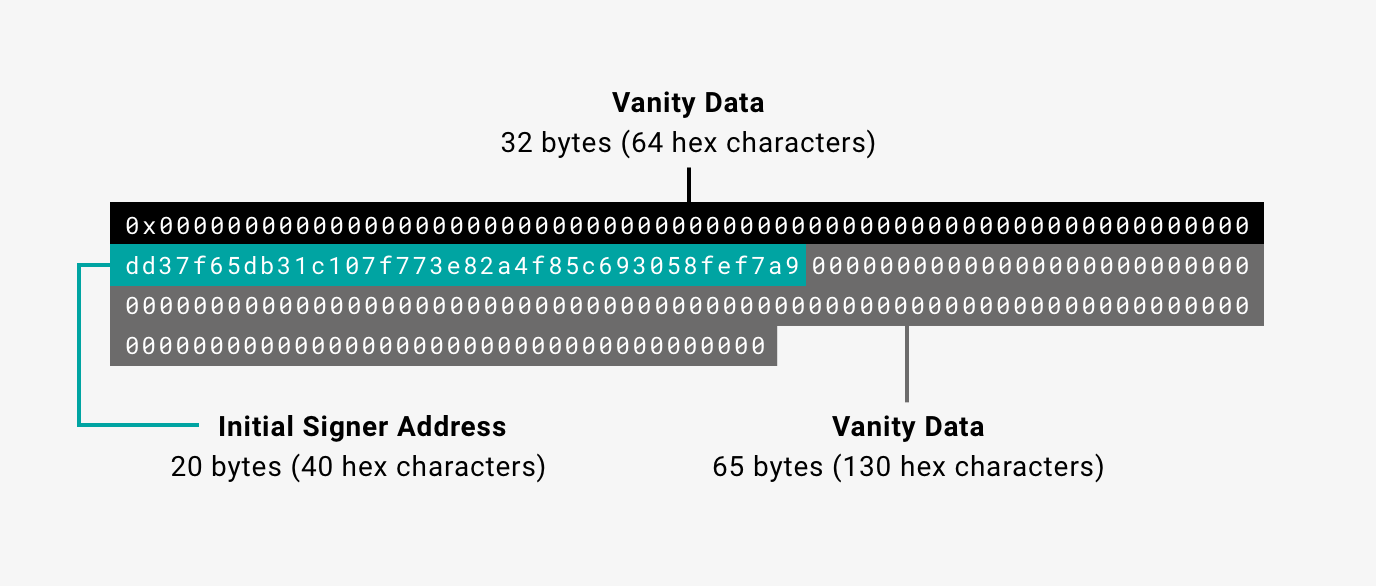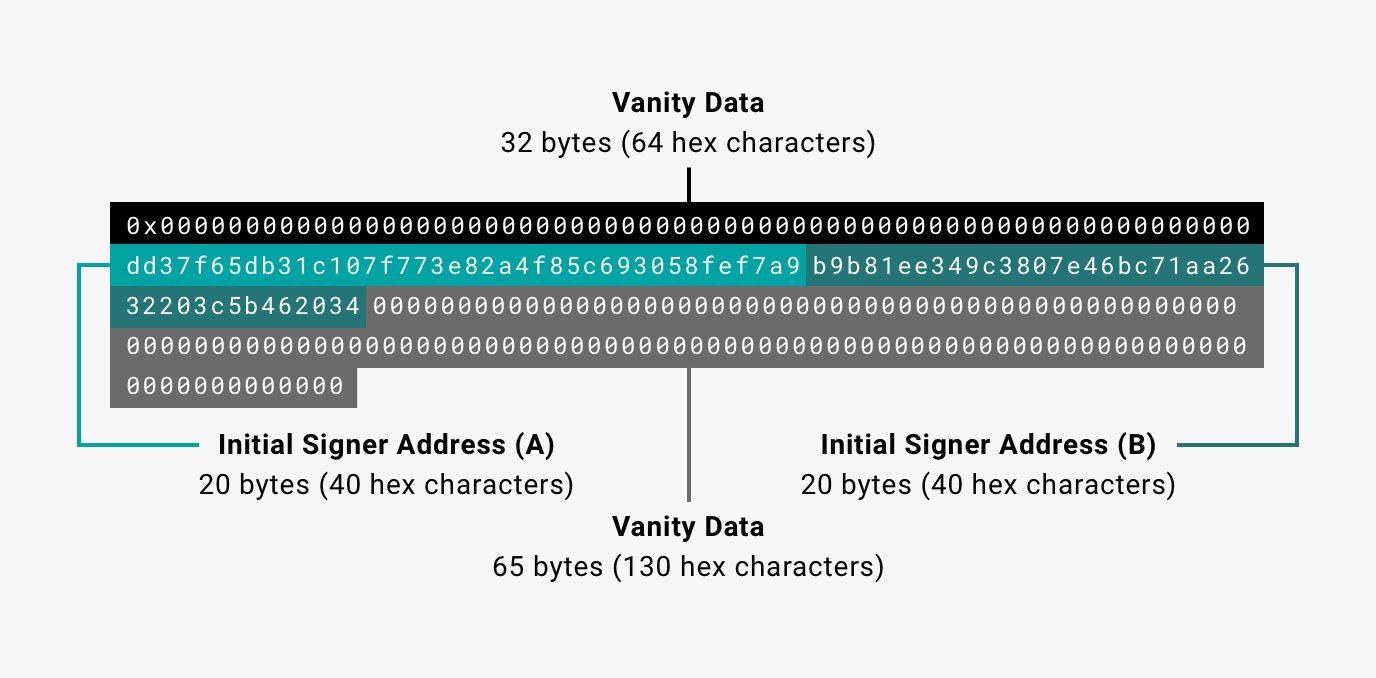Configure Clique consensus
Besu implements the Clique proof of authority (PoA) consensus protocol. Private networks can use Clique.
Clique is not suitable for production environments. Use only in development environments.
In Clique networks, approved accounts, known as signers, validate transactions and blocks. Signers take turns to create the next block. Existing signers propose and vote to add or remove signers.
You can create a private network using Clique.
Genesis file
To use Clique in a private network, Besu requires a Clique genesis file.
A Clique genesis file defines properties specific to Clique.
{
"config": {
"chainId": 1981,
"berlinBlock": 0,
"clique": {
"blockperiodseconds": 15,
"epochlength": 30000
}
},
"coinbase": "0x0000000000000000000000000000000000000000",
"difficulty": "0x1",
"extraData": "0x000000000000000000000000000000000000000000000000000000000000000001a54556254bfa3db2daa7673435ec63649925c50000000000000000000000000000000000000000000000000000000000000000000000000000000000000000000000000000000000000000000000000000000000",
"gasLimit": "0x1fffffffffffff",
"mixHash": "0x0000000000000000000000000000000000000000000000000000000000000000",
"nonce": "0x0",
"timestamp": "0x5c51a607",
"alloc": {},
"number": "0x0",
"gasUsed": "0x0",
"parentHash": "0x0000000000000000000000000000000000000000000000000000000000000000"
}
The properties specific to Clique are:
blockperiodseconds- The block time, in seconds.epochlength- The number of blocks after which to reset all votes.extraData- Extra data including the initial signers.
Extra data
The extraData property consists of:
- 0x prefix.
- 32 bytes of vanity data.
- A list of initial signer addresses (at least one initial signer is required). 20 bytes for each signer.
- 65 bytes for the proposer signature. In the genesis block there is no initial proposer, so the proposer signature is all zeros.
One initial signer

Two initial signers

Post-Merge configuration
After The Merge, the following block fields are modified or deprecated. Their fields must contain only the constant values from the following chart.
| Field | Constant value | Comment |
|---|---|---|
ommersHash | 0x1dcc4de8dec75d7aab85b567b6ccd41ad312451b948a7413f0a142fd40d49347 | = Keccak256(RLP([])) |
difficulty | 0 | Replaced with prevrandao |
mixHash | 0x0000000000000000000000000000000000000000000000000000000000000000 | Replaced with prevrandao |
nonce | 0x0000000000000000 | |
ommers | [] | RLP([]) = 0xc0 |
Additionally, extraData is limited to 32 bytes of vanity data after The Merge.
Connect to a Clique network
To start a node on a Clique private network, use the --genesis-file option to specify the custom genesis file.
Add and remove signers
Existing signers propose and vote to add or remove validators using the Clique JSON-RPC API methods. Enable the HTTP interface with --rpc-http-enabled or the WebSocket interface with --rpc-ws-enabled.
The Clique API methods are disabled by default. To enable them, specify the --rpc-http-api or --rpc-ws-api option and include CLIQUE.
The methods to add or remove signers are:
To view signer metrics for a specified block range, call clique_getSignerMetrics.
Add a signer
To propose adding a signer to a Clique network, call clique_propose, specifying the address of the proposed signer and true. A majority of signers must execute the call.
curl -X POST --data '{"jsonrpc":"2.0","method":"clique_propose","params":["0xFE3B557E8Fb62b89F4916B721be55cEb828dBd73", true], "id":1}' <JSON-RPC-endpoint:port>
When the signer creates the next block, the signer adds a vote to the block for the proposed signer.
When more than 50% of the existing signers propose adding the signer, with their votes distributed in blocks, the signer can begin signing blocks.
To return a list of signers and confirm the addition of a proposed signer, call clique_getSigners.
curl -X POST --data '{"jsonrpc":"2.0","method":"clique_getSigners","params":["latest"], "id":1}' <JSON-RPC-endpoint:port>
To discard your proposal after confirming the addition of a signer, call clique_discard specifying the address of the proposed signer.
curl -X POST --data '{"jsonrpc":"2.0","method":"clique_discard","params":["0xFE3B557E8Fb62b89F4916B721be55cEb828dBd73"], "id":1}' <JSON-RPC-endpoint:port>
Remove a signer
The process for removing a signer from a Clique network is the same as adding a signer, except you specify false as the second parameter of clique_propose.
Epoch transition
At each epoch transition, Clique discards all pending votes collected from received blocks. Existing proposals remain in effect and signers re-add their vote the next time they create a block.
Define the number of blocks between epoch transitions in the Clique genesis file.
Limitations
In Clique, blocks created by in-turn validators are published immediately. Out-of-turn validators create blocks that are published after a short delay. In-turn blocks have a higher difficulty than out-of-turn blocks, which allows small forks to resolve to the chain with more in-turn blocks.
However, when the out-of-turn delay is shorter than the block propagation delay, out-of-turn blocks may be published before in-turn blocks. This may cause large, irresolvable forks in a network.
*[vanity data]: Signers can include anything they like as vanity data.